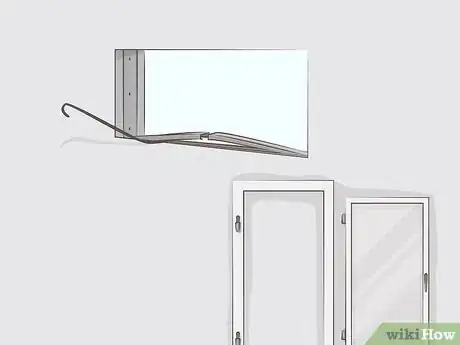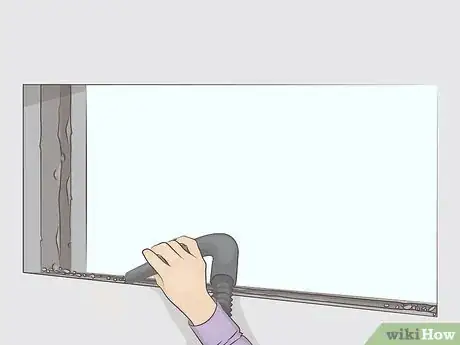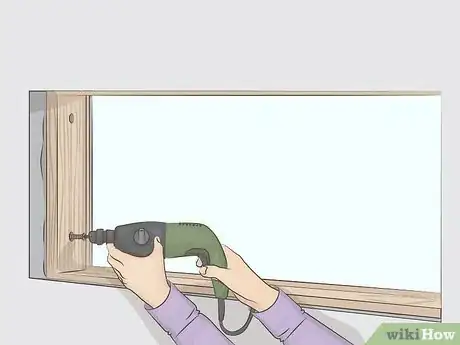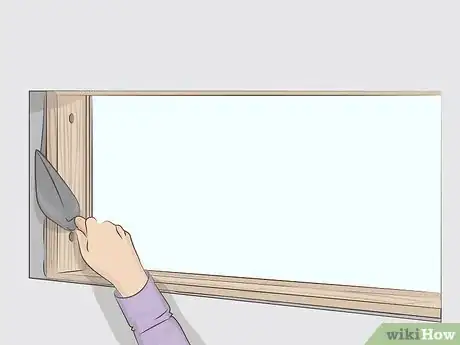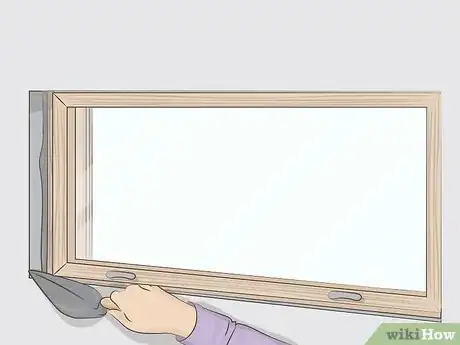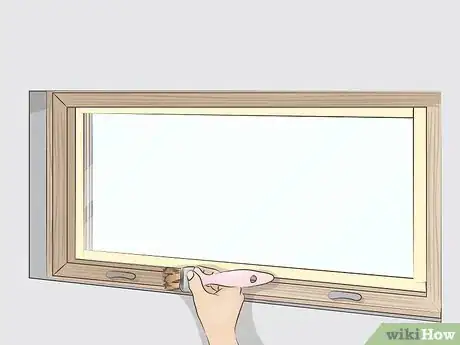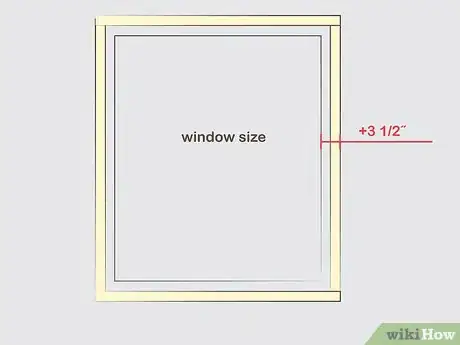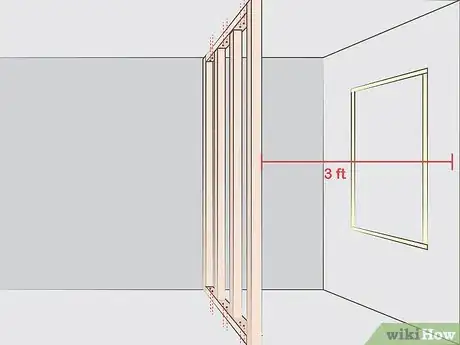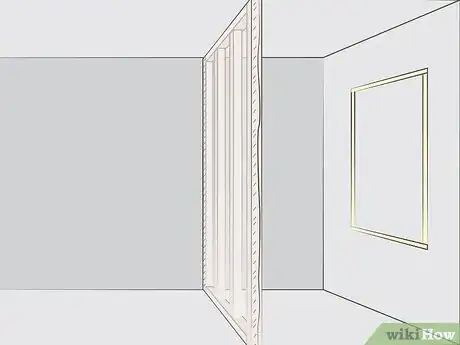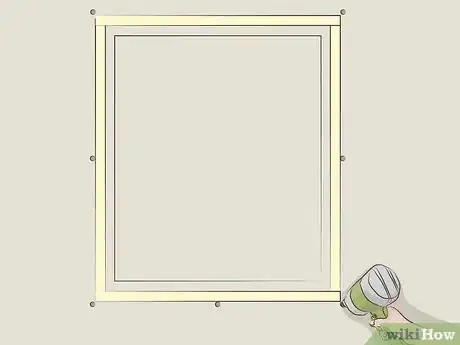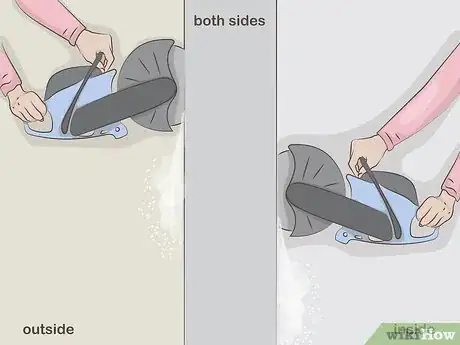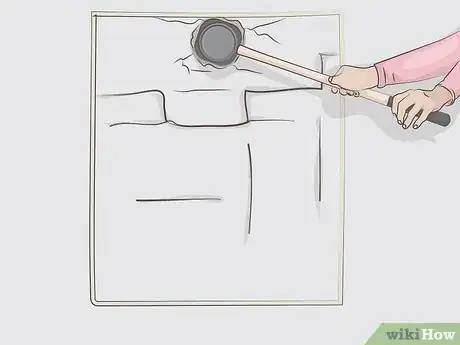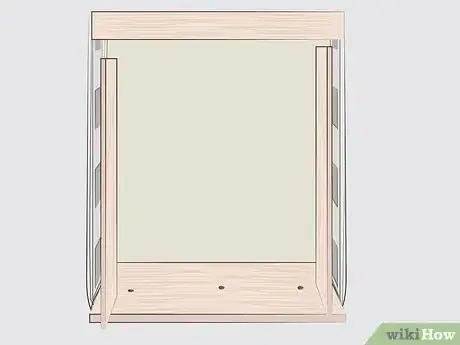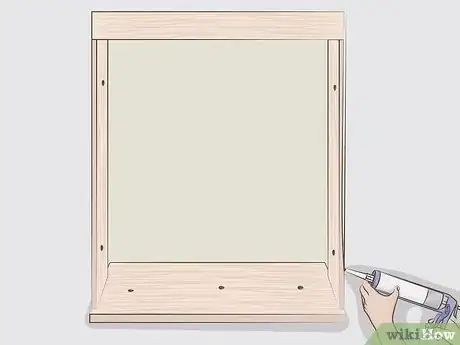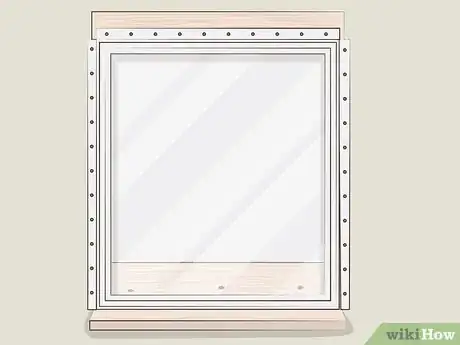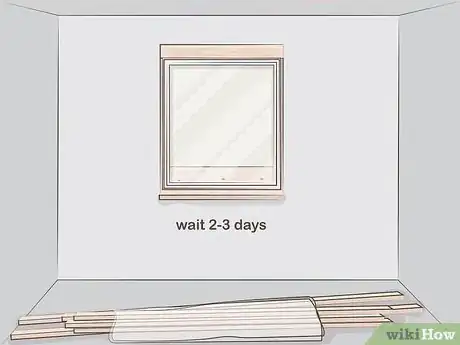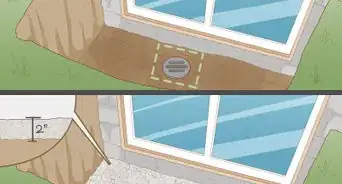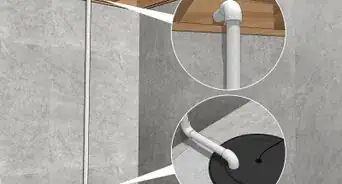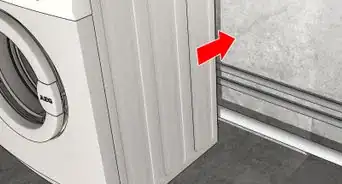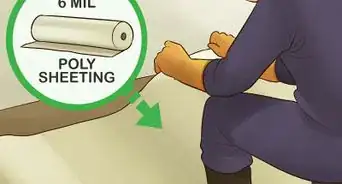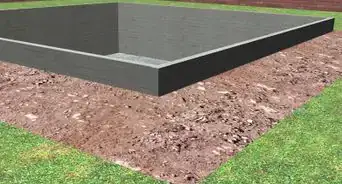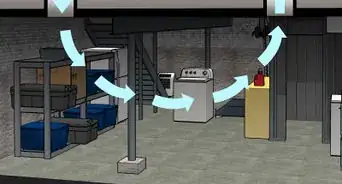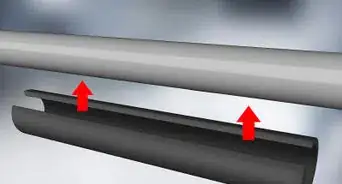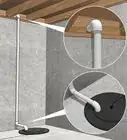This article was co-authored by Patrick Johns and by wikiHow staff writer, Jessica Gibson. Patrick Johns is a Home Improvement Specialist and the Owner of CatchAll Handyman Services. With more than 28 years of experience, he has worked on a variety of home improvement projects, such as carpentry, plumbing, and door and window installations in both commercial and residential properties.
This article has been viewed 86,316 times.
If you have a basement window that's in desperate need of an update, remove the frame and replace the window. Install a new window that fits the space and caulk around the frame to waterproof it. If you need to install a new window in a concrete wall, cut a hole that's large enough to hold your new window. Then make a custom frame and push the window in place.
Steps
Replacing a Basement Window
-
1Remove the wood frame and sash or metal buck frame. If you have a wooden-framed window, pry off the frame and sash using a pry bar. Then take a reciprocating saw and cut between the wall studs and the frame. If you have a metal window frame that's rusted, determine if it was screwed or riveted in place. Unscrew it if you can or use a drill to remove the rivets. Then pull away the metal frame from the surrounding concrete.[1]
- The wooden frame is also called a jamb while a metal frame is also called a buck.
- If the metal frame isn't rusted, you can typically leave it in place and replace just the window pieces.
-
2Measure the window frame so you know what size replacement to get. For a wooden window frame, measure the width and height of the frame. Use the inside measurements instead of the outside measurements since some window sills are sloped. If you're measuring a metal window frame, measure the height and width.[2]
- If you didn't take the frame out, you can simply measure the size of the window. If you can't get an exact size, order a slightly smaller window that you can fill in with mortar.
Advertisement -
3Clean the window opening and remove any ridges of mortar. Use a bucket-type vacuum to suck up any dust or debris from the window opening. If you have a concrete or brick opening, check for ridges that will make it difficult to install the new window. To remove concrete ridges, use a hammer and cold chisel to chip away the excess mortar.[3]
- If you don't want to chip away mortar ridges, consider buying a window that's smaller and won't need to be installed over the ridge.
-
4Place the replacement window in the frame and drill it in place. Take out the sash and screen from the new window to make it easier to get to the screw holes. Then carefully push the window into the opening. Use galvanized or stainless steel screws to screw the window in place.[4]
- If you're screwing the window into concrete, you'll have to screw double-threaded concrete screws using a hammer drill.
- Check to see if your replacement window came with screw cover plugs and put them on if so.
-
5Fill in the gaps between the window and foundation. Now that you've replaced the window, look to see if the window is flush with the surrounding foundation. If there are any gaps, you'll need to use a filler to seal the gap. Consider using one or more of these:[5]
- Mortar
- Mortar and brick or stone
- Caulk for the sides or top of the frame
- Urethane spray foam for under the will
- Custom-cut pipe insulation
-
6Put the window sash and screen back in and smooth away any mortar. Put any of the window parts back in place. Once the mortar or caulk is completely dry, use a smooth trowel to smooth the mortar or caulk so it's flush with the foundation of the window.[6]
- Read the mortar or caulk package to determine how long it needs to dry. Depending on the product, it may take a few hours to a few days to dry.
-
7Apply primer to the bare parts of the wooden window. If you're replacing a wooden window, you'll need to protect it from rain and the elements. Spread 1 coat of exterior-grade primer to the bare wood and let it dry according to the manufacturer's instructions.[7]
- Once the primer is dry, decide if you want to paint the wooden frame to match your home's trim.
Installing an Egress Window
-
1Measure the size of your window and get a permit. If you want a basement window that will satisfy egress codes, it needs to be at least 5.7 square ft (9.9 m) in size. Specifically, the window has to be at least 20 in (50 cm) wide and 24 in (61 cm) high. Once you know the size you want your window to be, take a sketch of it to your city's building inspector's office to get a building permit.[8]
- The bottom of the window can't be more than 44 in (1.1 m) from the floor. This ensures that the window is easy to use as an emergency entrance or exit.
-
2Choose a location for the window and mark the outline with tape. You may want to put the window on the wall that will give the best light and look the best from the exterior. Pay attention to any obstacles you might face when installing the window. Once you're satisfied with where to place the window, outline the window measurements on the wall using masking tape.[9]
- Make the outline 3 1/2 in (8 cm) wider and 1 3/4 in (4 cm) higher to account for the wooden frame.
- Obstacles for installation include buried utilities, plants growing on the exterior, wiring for the house, and ductwork. If you aren't sure if you have buried utilities or wiring, call your utility company before starting the project.
-
3Build a temporary support wall for additional support. If the joists are perpendicular to the wall you're cutting into, build a 2 x 4 ft (60 x 120 cm) support wall. Make the wall 3 ft (90 cm) in front of the wall you're cutting into. Screw the support wall firmly into place at the top and bottom where it meets the joists.[10]
- If the joists aren't perpendicular to the window wall or the window will be less than 48 in (1.2 m) wide, you can skip this step.
-
4Staple plastic sheeting to the temporary wall to catch the dust. Before you begin cutting into the wall, hang 6-mil plastic sheeting from the temporary wall and staple it in place. Cut slits in the plastic so you can lift it up and staple the sheeting in between the joists.[11]
- The plastic will contain the dust and debris from cutting which will make clean up easier.
-
5Mark the cutting lines and drill through pilot holes on the corners. Measure and mark the dimensions of the window on the exterior using masking tape. Use a hammer drill and a long bit to drill pilot holes through the middle of the bottom cutting line. You'll also need to drill level holes at the corners of the window so they go through the wall.[12]
- Use a level to ensure that you're marking the window accurately. Use the measuring lines as guides when you drill.
-
6Use a concrete saw to cut the interior and exterior outline of the window. Use a 14 inch (35 cm) concrete saw with a diamond blade to cut the outline of the window from the inside and outside. Make the cut about 1/2 in (1.3 cm) deep. You'll need to go around the outline twice with the saw, making a 1/2 in (1.3 cm) deep cut the second time as well.[13]
- If the saw is making too much dust as it cuts the concrete, wet the blade.
-
7Knock out the concrete and smooth the opening. Take a 4 lb (1.8 kg) sledgehammer and hit the concrete near the top part of the window's center. Then hit around the center edges of the window. The concrete will begin to fall out of the wall. Once most of it is out, use a brick chisel to remove small bits of concrete that remain.[14]
- At this point you can check to ensure that the rough frame and window will fit the opening you just made.
-
8Fill the exposed wall blocks with newspapers and concrete. Take several newspapers and crumple them up. Stuff them into the exposed concrete blocks. Then use a cement trowel to fill the blocks with concrete and cover them with plastic sheeting.[15]
- The newspapers will prevent the concrete from falling down through the blocks.
- The plastic sheeting will prevent the water from the concrete from warping the window frame sill.
-
9Install and screw the sill and frame in place. To install the sill, screw 3 in (7.5 cm) deck screws through the wood into the wet concrete. Then push the header in place and screw it to the floor joists. Install the frame sides so they fit tightly and bang them into place. Drill screws at a an angle through the frame sides.[16]
- The frame sides will support the header.
-
10Anchor the frame and caulk around it. Use two 3/16 x 3 1/4 in (.5 x 8.2 cm) concrete screws to secure the frame to the block wall. Then use a polyurethane or exterior caulk to fill in gaps between the frame and concrete.[17]
- If you want the screws to be flush to the frame, countersink them so they don't extend past the frame.
- If the gaps are wider than 1/4 in (6 mm), install a foam backer rod into the gap. Then seal with the caulking.
-
11Caulk around the inside of the frame and install the window. Get help to hold up the new window and center it in place. Then remove the window so you can caulk around the wood frame. Put the window back in place and ensure it's level. Drill screws into the nailing fin so the window is secured.[18]
- Check your specific nailing fin to see if it's supposed to be nailed in place instead screwed in place.
-
12Remove the temporary wall and let the window dry for 2 to 3 days. Pull down the plastic sheeting you installed to contain dust and then take down the temporary support wall. Leave the new window to set and dry before you paint or use the window.[19]
- It may take longer for your window to set if your basement is very damp or humid.
Community Q&A
-
QuestionHow do I get more light from those tiny basement windows?
 Community AnswerTry using mirrors to reflect light to different areas of the room. Even just painting the windowsill and any other surrounding shoulders bright white can dramatically increase the window light output.
Community AnswerTry using mirrors to reflect light to different areas of the room. Even just painting the windowsill and any other surrounding shoulders bright white can dramatically increase the window light output. -
QuestionCan I use pressboard or interior window sill?
 Community AnswerPressboard (particle board) is an inexpensive option for a new windowsill frame.
Community AnswerPressboard (particle board) is an inexpensive option for a new windowsill frame. -
QuestionWe are ready to install two basement windows. There is an R/O with wood trim. Do we have to remove the wood R/O before we install the windows or do the windows sit in this opening?
 Community AnswerNo, not if the windows fit. As long as they're in good shape, there's no law against re-using them nor keeping them undisturbed. However, if they're just blocking empty space or minor gaps, I'd remove them and insulate the new window to be air, water and bug-tight.
Community AnswerNo, not if the windows fit. As long as they're in good shape, there's no law against re-using them nor keeping them undisturbed. However, if they're just blocking empty space or minor gaps, I'd remove them and insulate the new window to be air, water and bug-tight.
Warnings
- Always wear safety equipment such as a mask and safety goggles.⧼thumbs_response⧽
- While you can cut through concrete block walls safely, you should hire a professional to cut the window if your basement walls are poured concrete.[20]⧼thumbs_response⧽
Things You'll Need
Replacing a Basement Window
- Cold chisel
- Reciprocating saw
- Pry bar
- Hammer
- Replacement window
- Galvanized or stainless steel screws
- Power drill and screw driver
- Double-threaded concrete screws
- Hammer drill
- Bucket-type vacuum
- Filler for gaps
- Smooth trowel
- Paint brush
- Exterior-grade primer
- Safety glasses, dust mask, and hearing protection
Installing an Egress Window
- Masking tape
- Tape measure
- 6-mil plastic sheeting
- 2 x 4 ft (60 x 120 cm) lumber for temporary wall
- 3 in (7.5 cm) deck screws
- Hammer drill with long bit
- Concrete saw with a 12 or 14 in (30 or 35.5 cm) blade
- Safety glasses, dust mask, and hearing protection
- Brick chisel
- 4 pounds (1.8 kg) sledgehammer
- Level
- Caulk gun
- Concrete
- Concrete trowel
- Newspapers
- Shims, optional
References
- ↑ http://www.aconcordcarpenter.com/how-to-replace-a-basement-window.html
- ↑ http://www.aconcordcarpenter.com/how-to-replace-a-basement-window.html
- ↑ https://www.thisoldhouse.com/how-to/how-to-replace-basement-window
- ↑ http://www.aconcordcarpenter.com/how-to-replace-a-basement-window.html
- ↑ http://www.aconcordcarpenter.com/how-to-replace-a-basement-window.html
- ↑ http://www.aconcordcarpenter.com/how-to-replace-a-basement-window.html
- ↑ https://www.thisoldhouse.com/how-to/how-to-replace-basement-window
- ↑ https://www.familyhandyman.com/basement/how-to-install-basement-windows-and-satisfy-egress-codes/view-all/
- ↑ https://www.familyhandyman.com/basement/how-to-install-basement-windows-and-satisfy-egress-codes/view-all/
- ↑ https://www.familyhandyman.com/basement/how-to-install-basement-windows-and-satisfy-egress-codes/view-all/
- ↑ https://www.familyhandyman.com/basement/how-to-install-basement-windows-and-satisfy-egress-codes/view-all/
- ↑ https://www.familyhandyman.com/basement/how-to-install-basement-windows-and-satisfy-egress-codes/view-all/
- ↑ https://www.familyhandyman.com/basement/how-to-install-basement-windows-and-satisfy-egress-codes/view-all/
- ↑ https://www.familyhandyman.com/basement/how-to-install-basement-windows-and-satisfy-egress-codes/view-all/
- ↑ https://www.familyhandyman.com/basement/how-to-install-basement-windows-and-satisfy-egress-codes/view-all/
- ↑ https://www.familyhandyman.com/basement/how-to-install-basement-windows-and-satisfy-egress-codes/view-all/
- ↑ https://www.familyhandyman.com/basement/how-to-install-basement-windows-and-satisfy-egress-codes/view-all/
- ↑ https://www.familyhandyman.com/basement/how-to-install-basement-windows-and-satisfy-egress-codes/view-all/
- ↑ https://www.familyhandyman.com/basement/how-to-install-basement-windows-and-satisfy-egress-codes/view-all/
- ↑ https://www.familyhandyman.com/basement/how-to-install-basement-windows-and-satisfy-egress-codes/view-all/
About This Article
To install a replacement basement window, remove the frame and sash, then measure the window frame so you know what size to get. Clean the window opening to remove any debris before you place the replacement window in the frame. After you screw the window into the frame, fill in any gaps with mortar, caulk, or spray foam. Then, put the window sash and screen back in and smooth away any mortar or caulk. Read on to learn how to install an egress window in your basement!
